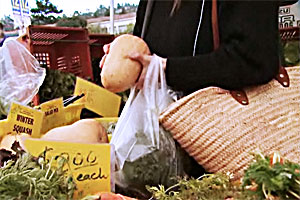 Not everyone would be excited about a box of 16 pounds of meat. But for the members of the Bay Area Meat CSA, the enthusiasm was off the charts. I took part in their spring share this year, where member of the CSA receive a monthly box of pork, poultry, lamb and beef from local Bay Area Farms. The idea began when blogger Bonnie Powell of The Ethicurean put out a call to her readers. Many of them were already getting vegetable CSA's - a meat CSA seemed a logical step. Since then, Tamar Adler, a cook at Chez Panisse stepped in to help run it. And running it is no easy task. This past spring, they were distributing 1,000 pounds a month to members.
Not everyone would be excited about a box of 16 pounds of meat. But for the members of the Bay Area Meat CSA, the enthusiasm was off the charts. I took part in their spring share this year, where member of the CSA receive a monthly box of pork, poultry, lamb and beef from local Bay Area Farms. The idea began when blogger Bonnie Powell of The Ethicurean put out a call to her readers. Many of them were already getting vegetable CSA's - a meat CSA seemed a logical step. Since then, Tamar Adler, a cook at Chez Panisse stepped in to help run it. And running it is no easy task. This past spring, they were distributing 1,000 pounds a month to members.
Since the CSA only buys whole animals, members get a few interesting things in each delivery. As Adler says, not every cut on an animal is a grill-able cut. Some cuts require other cooking techniques, and so members are challenged to do braises and stews with what they get. The idea is to create a new market for many of the local, small-scale producers. And Adler says she's been getting phone calls from many others looking to join.
Adler has decided the CSA will take the summer off, so she can work on restructuring it into a more cooperative model. As she says, one of the goals of the CSA is for consumers to connect with their producers and she's hoping the CSA's structure can reflect that. The good news is a number of other meat CSA's have arrived on the scene in the Bay Area for those of you looking to join one. Those are:
- The Clark Summit Meat Club
- Sonoma County Meat Buying Club
- Marin Sun Farms
- And here's a list of meat CSA's nationwide
As I also discovered in this story, eating a low-carbon diet is not simple. Researchers are just starting to get a handle on the methodology used to do a life cycle analysis for food. And the news isn't good for meat and cheese lovers - it turns out red meat and dairy products have the highest carbon footprints. The further you dive into their life cycle, the more complicated it gets. Luckily, Gail Feenstra of UC Davis's Sustainable Agriculture Research and Education Program has a few simple tips to cut your carbon.
- Eat less red meat and dairy
- Avoid foods grown in heated greenhouses by eating seasonal food
- Avoid food transported by air by eating locally
- Consolidate your shopping into as few trips as possible
- Waste less food. If it goes into a landfill, it emits the same gases as cows
You can get a sense of the footprint of your diet through the Bon Appetit Management Company's Eat Low Carbon Calculator or you can look up a local farmer's market with Local Harvest.
